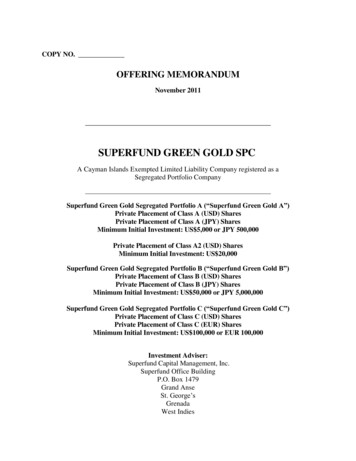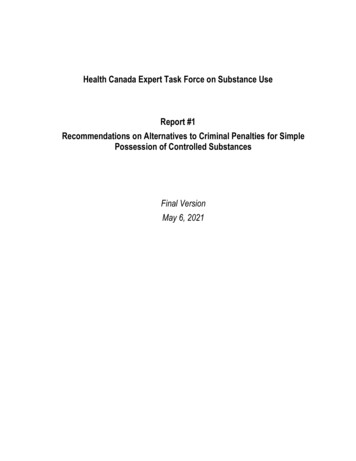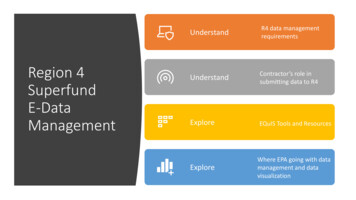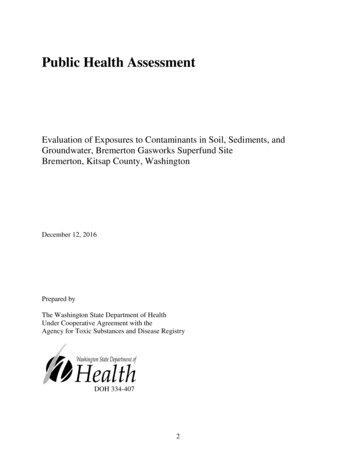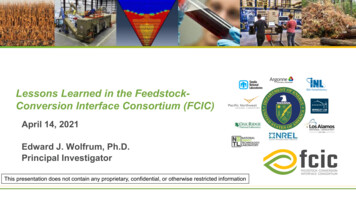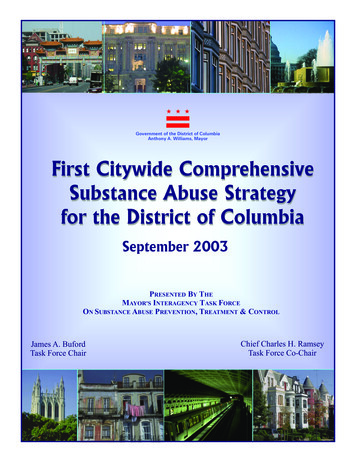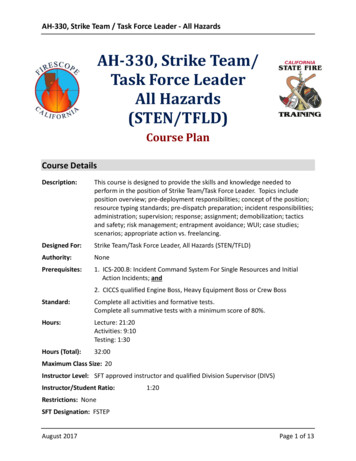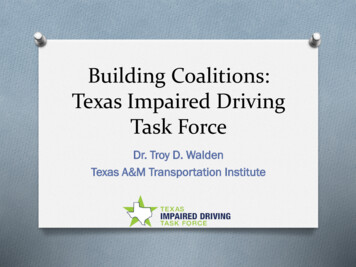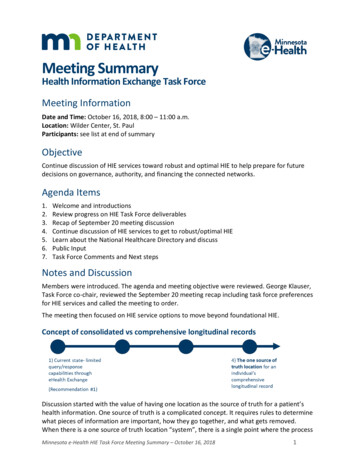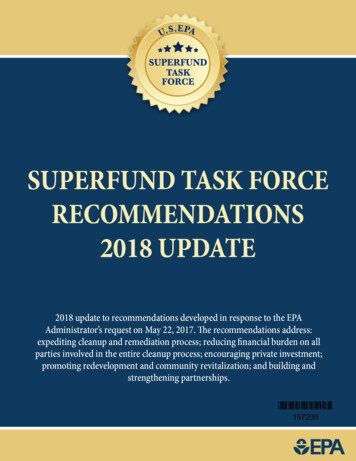
Transcription
*197209*197209
July 23, 2018The core mission of the U.S. Environmental Protection Agency (EPA) is to protect human healthand the environment and ensure all Americans have access to safe and clean air, land, and water.As such, a key responsibility of the Agency is cleaning up and revitalizing contaminated land andreturning it to use so that communities can utilize and enjoy it.Since 1980, EPA’s Superfund program has helped protect human health and the environment bymanaging the cleanup of the nation’s worst hazardous waste sites and responding to local andnationally significant environmental emergencies.The Superfund Task Force represents EPA’s commitment to continuously look for opportunitiesto identify and resolve environmental challenges. The recommendations in the Superfund TaskForce Report address barriers that delay the cleanup and redevelopment of contaminated sites.Implementing these recommendations will ensure EPA is able to remediate and revitalize evenmore sites throughout the nation.I am proud to present the 2018 Update to the Superfund Task Force Report, which highlightsthe numerous accomplishments achieved by the hard-working EPA staff who planned andimplemented specific actions to expedite reduction of risks to human health and the environmentand accelerate the reuse of properties affected by hazardous substance contamination. Theaccomplishments are many indeed and have led to significant progress at Superfund sitesthroughout the country. I am grateful for the assistance of our partners and stakeholders in theprogress made thus far, and I look forward to continuing our successful partnership.The report also outlines next steps for all open recommendations and emphasizes a continuedcommitment to engage partners and stakeholders at all levels in making cleanup and landrevitalization decisions that will provide future generations with a cleaner and healthierenvironment.I look forward to working together with states, local communities, tribes, and private parties aswe continue the environmental and economic restoration work happening across the nation.Respectfully,Andrew WheelerActing AdministratorS U P E R F U N D TA S K F O R C E R E C O M M E N D A T I O N S 2 0 1 8 U P D A T E3
4S U P E R F U N D TA S K F O R C E R E C O M M E N D A T I O N S 2 0 1 8 U P D A T E
CONTENTSActing Administrator’s Statement . . . . . . . . . . . . . . . . . . . . . . . . . . . . . . . . . . . . . . . . . . . . . . . . . . . . . . . . . . . . . . . 3Executive Summary . . . . . . . . . . . . . . . . . . . . . . . . . . . . . . . . . . . . . . . . . . . . . . . . . . . . . . . . . . . . . . . . . . . . . . . . . . 7Chapter 1 . . . . . . . . . . . . . . . . . . . . . . . . . . . . . . . . . . . . . . . . . . . . . . . . . . . . . . . . . . . . . . . . . . . . . . . . . . . . . . . . . 13Chapter 2 . . . . . . . . . . . . . . . . . . . . . . . . . . . . . . . . . . . . . . . . . . . . . . . . . . . . . . . . . . . . . . . . . . . . . . . . . . . . . . . . . 55S U P E R F U N D TA S K F O R C E R E C O M M E N D A T I O N S 2 0 1 8 U P D A T E5
6S U P E R F U N D TA S K F O R C E R E C O M M E N D A T I O N S 2 0 1 8 U P D A T E
EXECUTIVE SUMMARYThe core mission of the Environmental Protection Agency (EPA) is toprotect human health and the environment. The Superfund programmakes a visible and lasting difference in communities by cleaning up thenation’s worst hazardous waste sites; tackling threats to public health andour natural environment; supporting local economies and enhancing thequality of life; and preventing future hazardous substance releases. TheSuperfund program’s achievements represent significant contributions inmeeting the Agency’s mission.Superfund’s National Priorities List (NPL) is the list of sites of nationalpriority among the known releases or threatened releases of hazardoussubstances, pollutants, or contaminants throughout the United Statesand its territories. Although many sites included on the NPL have beenremediated and removed from the list, numerous sites remain and eachyear sites are added to the list.As of July 3, 2018, there are 1,346 sites on the NPL, of which 1,189 are private sites and 157 are federal facilities. Assites move through the remediation process and cleanup objectives have been met, they will be deleted from theNPL. To date, 399 sites have been deleted from the NPL.As noted above, the Superfund program has many demonstrated achievements over its 40-year existenceand has periodically reviewed and improved the program. EPA continues to seek ways to more efficientlyand effectively remediate Superfund sites. The Superfund Task Force was commissioned on May 22, 2017, to,“provide recommendations on an expedited timeframe on how the agency can restructure the cleanup process,realign incentives of all involved parties to promote expeditious remediation, reduce the burden on cooperatingparties, incentivize parties to remediate sites, encourage private investment in cleanups of sites and promote therevitalization of properties across the country.” On July 25, 2017, the Superfund Task Force developed a report thatincluded 42 recommendations in five specific goal areas including: Expediting Cleanup and Remediation; ReInvigorating Responsible Party Cleanup and Reuse; Encouraging Private Investment; Promoting Redevelopmentand Community Revitalization; and Engaging Partners and Stakeholders. The Superfund Task Force Report canbe found at /documents/superfund task force report.pdf.Implementation of these recommendations was initiated during Year 1, July 2017 through July 2018.S U P E R F U N D TA S K F O R C E R E C O M M E N D A T I O N S 2 0 1 8 U P D A T E7
Chapter 1 of this report describesthe accomplishments under eachSuperfund Task Force RecommendationsCompletion Scheduleof the recommendations alongwith status, completion dates,refinements made, and integrationof the recommendation into theprogram. As outlined in Chapter 2,45%52%December 201859%March 2019some of the recommendations willbe completed throughout Year 2.27%July 2018September 201882%June 2019100%September 2019020406080100ACCOMPLISHMENTS:For each of the recommendations, EPA convenedworkgroups and identified specific implementing tasks. TheSuperfund Task Force workgroups worked diligently to findthe most efficient ways to implement the recommendationsand reach outcome-driven results that expedite sitecleanups, site redevelopment and community revitalization.Below are a few highlights:Implemented Administrator Review of RemedyDecisions Equal to or Greater than 50MReleased Administrator’s Emphasis ListFocused Optimization Evaluations on PrioritySitesEPA released the Administrator’s Emphasis List (AEL) onDecember 8, 2017. The list included 21 sites from across theUnited States that EPA targeted for immediate and intenseattention. Substantial progress has been made at sites on thelist. The next update of the AEL will be published at the endof July 2018.Improved Information on Human ExposureStatusEPA launched a Human Exposure Dashboard that providesreal time determinations of human exposure status for allNPL sites in an easily accessible webpage. The Superfundprogram has successfully effectuated control at a net totalof 24 sites in FY2017 and 20 sites thus far in FY2018,compared to 12 sites in FY2016.Moved More Sites Toward Deletion/PartialDeletionDue to more direct attention to the sites potentially eligiblefor partial or full deletion, the program achieved 2 fullsite deletions and 4 partial deletions in FY2017, and asof July 1, 2018, has accomplished 5 full deletions and 1partial deletion. EPA is on track for 10 or more deletions inFY2018.8To ensure timely involvement by the Administrator’s office,the Superfund program developed, and is implementing,the Administrator’s review and approval process forproposed remedial actions that may be equal to or exceed 50 million.Since July 2017, EPA has implemented 18 optimizationevaluations and is considering 17 additional optimizationcandidates. To prioritize allocation of optimizationresources, EPA has established criteria to prioritize siteattributes tied to Task Force recommendations, such ashuman exposure not under control; large and complex, suchas sites with remedies greater than 50 million; stakeholderinterests or concerns; projected completion dates within5-15 years, where optimization may accelerate closure; andplacement on the AEL. EPA is also implementing severalprojects to advance optimization practices and related toolsin all phases of cleanup.Completed Fact Sheets on Best ManagementPractices to Facilitate Site InvestigationsTo assist in the planning process for remedial investigations,EPA completed three facts sheets containing bestmanagement practices (BMPs) related to scoping, samplingand data management: “Smart Scoping for EnvironmentalInvestigations Technical Guide,” “Strategic SamplingApproaches Technical Guide,” and “Best Practices for DataManagement Technical Guide.” These documents will beposted on EPA’s website in the coming months.S U P E R F U N D TA S K F O R C E R E C O M M E N D A T I O N S 2 0 1 8 U P D A T E
Implemented Superfund Technical Support,Training, and Information SharingSince July 2017, EPA implemented over 15 site-specifictechnical support projects related to site characterizationand cleanup; conducted numerous webinars for EPAremedial project managers and other EPA cleanupprofessionals; published two technical fact sheets relatedto improved implementation of in-situ technologies; andfinalized improved technical resource web pages.Developed On-Line In-House Tool to LocateTechnical ExpertsEPA developed an internal electronic tool to allow regionalSuperfund staff to easily locate Agency technology andpolicy experts. The tool also allows EPA staff to sharetheir expertise on innovative technology pilots anddemonstrations.Issued New Guidance on Separate Tracks forRemedial Design and Remedial ActionsEPA issued a new guidance memorandum titled,“Bifurcating Remedial Design and Remedial Action toAccelerate Remedial Design Starts at PRP-Lead SuperfundSites.” The guidance recommends that Regions considerusing separate settlement tracks for remedial design andremedial action to get work underway quickly wherenegotiations for a single consent decree addressing bothremedial design/remedial action are likely to be protracted.Developed Tools and a Processes to EncourageThird-Party InvestmentBecause third-party entities such as developers are generallyon aggressive timeframes to complete land developmentinvestments, EPA created a national team of redevelopmentexperts led by EPA and the Department of Justice (DOJ)to help move cases through the legal system and addressliability concerns. EPA and DOJ issued a new policymemorandum titled “Agreements with Third Parties toSupport Cleanup and Reuse at Sites on the SuperfundNational Priorities List.” The memorandum encouragesmore frequent consideration of Bona Fide ProspectivePurchaser (BFPP) agreements and Prospective PurchaserAgreements (PPAs), when appropriate, to foster cleanupand reuse of NPL sites.Promote Redevelopment and CommunityRevitalizationIn January 2018, EPA released the initial RedevelopmentFocus List of 31 NPL Superfund sites with the greatestreuse potential. Since the list’s release, EPA has respondedto over 120 redevelopment-related prospective purchaserinquiries and has issued reuse fact sheets for all sites plusan additional 32 sites. EPA also created a new mapping toolthat provides map-based search capabilities for Superfundsite maps depicting site-specific information related to the31 Redevelopment Focus List sites.Issued New Guidance on the Use of SpecialAccounts as a Settlement IncentiveEPA has worked to engage communities affected by EPAcleanup and redevelopment by providing relevant trainingsand information on Superfund and Brownfield processes.EPA published over 20 case studies, fact sheets, reports andonline materials.Drafted Model Settlement Language for Siteswith Federal Potentially Responsible PartiesEPA provided technical assistance to over 20 communitiesin 9 regions through regional seed projects and ongoingregionally funded support; published five technical reusereports that highlight reuse planning processes andoutcomes at sites that have received technical assistance;and supported a Superfund Job Training Initiative project atMadison County Mines site in Region 7. In March 2018, 24residents graduated from the program and job placement ofgraduates is ongoing.EPA issued an Updated Special Account DisbursementGuidance to provide guidance to regions on disbursingspecial account funds to bona fide prospective purchasersas an incentive to perform work as well as to potentiallyresponsible parties as settlement incentive.EPA has accelerated the process for resolving settlementissues at sites with Federal PRPs. EPA developed modelsettling Federal agency language to address commonsettlement delays. EPA will continue to streamline thesettlement process for sites involving Federal PRPs and willfinalize the model language in Year 2.Created New Tools Related to Federal FacilityInformal and Formal Dispute TimelinesEPA created two tools to reinforce adherence to informaland formal dispute timelines in Federal Facility Agreements(FFAs) at NPL Federal Facility sites.Engaging Partners and StakeholdersEPA has long recognized the importance of early andmeaningful participation of stakeholders, and will continueto enhance community and stakeholder engagement topromote transparency, community support, and moretimely cleanup decisions. EPA will also continue to buildstrong strategic partnerships with communities andstakeholders to implement the Superfund Task Forcerecommendations. Implementing clear and effectivecommunication and public engagement processes will helpS U P E R F U N D TA S K F O R C E R E C O M M E N D A T I O N S 2 0 1 8 U P D A T E9
accelerate the pace of cleanups and encourage reuse whileaddressing risks to human health and the environment. Asan example of ongoing outreach activities, the SuperfundCommunity Involvement Program competed the followingactivities between July 25, 2017, and June 27, 2018: EPAheld or participated in more than 1,370 public meetings;conducted or participated in more than 3190 in-personmeetings or interviews; and distributed more than460 factsheets, mailings, postcards, ads or newslettersthat reached tens of thousands of people living nearSuperfund sites. In addition, senior EPA leaders meet withenvironmental justice groups on a quarterly basis to discusscommunity needs.The Environmental Council of States (ECOS) formed anECOS-EPA Superfund Workgroup to work with EPA onimplementing the Superfund Task Force recommendations.The workgroup holds monthly calls with EPA to discussstate comments on Task Force recommendations andprovides state input on implementation moving forward.EPA and the Association of State and Territorial Solid WasteManagement Officials (ASTSWMO) developed an approachfor providing ongoing state input from both ASTSWMOand ECOS. EPA is working with the National Tribal Caucuson an engagement process during implementation of therecommendations and moving forward in the Superfundprocess.10EPA maintains a webpage to inform the public and a broadrange of partners, stakeholders, and tribes about the statusand results of the recommendations, including quarterlyupdates on the status of the recommendations. The webpagealso features information about events and opportunitiesfor public participation, input and comment for theimplementation of individual recommendations.EPA’s Office of Enforcement and Compliance Assurancehosted eight listening sessions to solicit public andstakeholder input related to specific recommendations andto report on the progress to date on activities related tothe recommendations. More than 650 persons registeredto participate in the eight sessions, representing externalstakeholders from the legal community (private attorneysand law schools); corporations and companies; state,municipal and tribal agencies; environmental and othernon-profit groups; and public citizens. The listeningsessions were part of the Agency’s efforts to increasepublic participation and transparency, and strengthencommunication with stakeholders. Recordings of thelistening session can be accessed at: -superfund-task-forcerecommendations. OECA representatives also attendedthe Environmental Bankers Association Conference inJune 2018 to receive stakeholder input from lenders andto report on progress to date on activities related to therecommendations.S U P E R F U N D TA S K F O R C E R E C O M M E N D A T I O N S 2 0 1 8 U P D A T E
NEXT STEPSIn Year 2, EPA will finalize implementation of all therecommendations designed to expedite reduction of risks tohuman health and the environment and accelerate the reuseof properties. As with the Year 1 recommendations, oncethe Year 2 actions are finalized, EPA will integrate theminto program processes and develop mechanisms to ensuresustainability and continuous improvement.In Year 2, EPA will finish implementing the RemedialAcquisition Framework (RAF), a series of multiple award,indefinite quantity contracts that will be competitivelyawarded in 2018 and 2019. When RAF becomesoperational, EPA will expand the pool of vendors availablefor Superfund remedial program activities. To fosterinnovation and reduce costs, EPA will compete tasks amongthe pool of RAF contract holders.EPA will continue to evaluate sites to move them towarddeletion and will place even greater emphasis on theinternal tracking of site progress using visual managementtools to evaluate where the site is in the Superfund process,how long it has been there, and reasons for any delays.Adaptive Management will be more widely utilized as asite project management tool in Year 2. Some elements ofAdaptive Management principles have been used by EPA inthe past. EPA is diligently working on an implementationplan for using Adaptive Management on a more structuredand broader scale and is planning to formally implementAdaptive Management principles at select pilot sites by theend of calendar year 2018.EPA will collaborate with ASTSWMO to complete athorough evaluation of groundwater beneficial use policieswith a focus on beneficial use determinations.To continue to re-invigorate responsible party cleanup andreuse, EPA will explore options for revising and managingnegotiation timeframes. This includes compiling bestpractices to reduce negotiation and PRP-lead cleanuptimeframes, and modifying model agreement language tospeed up timeframes and to provide financial incentivesin the form of reduced oversight when appropriate. EPAwill also continue to look for efficiencies with other federalagencies and states in overseeing and implementingcleanups. In addition, EPA may pilot an approach suggestedby stakeholders, during a listening session conducted onthis topic, whereby an existing company spins off a new,but related (and sufficiently funded) corporate entity forthe purpose of being the primary party responsible forperforming cleanup, including at a portfolio of sites.To continue to encourage private investment in cleanupand reuse of contaminated sites, EPA will finalize revisionsto the “Common Elements Guidance” to assist thirdparties with identifying and creating opportunities fornew investment in cleaning up contaminated sites. EPAwill also finalize revisions to the 2015 Comfort/StatusLetter policy and model letter to provide more certaintyin EPA’s comfort language. This includes developing anew model work agreement and comfort letter for GoodSamaritans and other third parties to encourage cleanupand redevelopment.EPA will continue focusing on identifying, supportingand tracking the redevelopment opportunities atSuperfund sites. Through ongoing training for EPA staffand communities EPA will continue to build capacityand awareness around the benefits that redevelopmentoffers. Specifically, EPA will continue to inform potentialdevelopers about key components of land use and economicdevelopment planning and funding, and financing toolswhich will provide better support to communities andpromote redevelopment of Superfund sites. A continuedfocus on early planning at the local level, especially duringthe Remedial Investigation/Feasibility Study phase ofcleanup, will allow for better partnership building and landuse options.EPA will also continue to provide communities andpotential developers with a variety of information in theform of online resources, fact sheets, economic analysis,outreach, and visioning opportunities in a sustained effortto keep sites visible and attractive to developers.Successful reuse depends on EPA’s ability to providecommunities and developers with the information theyneed to determine the future of Superfund sites. We willexpand outreach efforts to ensure that information about allpotential reuse sites is visible and available to communitiesand developers. The expansion of work that will continuein 2019 will pave the way for communities to benefit fromenhanced quality of life, a safe and healthy environment andeconomic growth.EPA will continue to focus on stakeholder and partnerengagement at all levels of the Superfund process tomake the process more efficient and promote communityrevitalization. Specific actions will include supportingrisk communication, especially as it relates to long-termstewardship (LTS) at Superfund sites.Opportunities to participate in the implementation processwill continue to be posted on the Superfund Task Force webpage at public-participation-opportunities.S U P E R F U N D TA S K F O R C E R E C O M M E N D A T I O N S 2 0 1 8 U P D A T E11
12S U P E R F U N D TA S K F O R C E R E C O M M E N D A T I O N S 2 0 1 8 U P D A T E
Chapter 1:SUPERFUND TASK FORCEYEAR 1 ACCOMPLISHMENTSThe July 25, 2017, Superfund Task Force Report identified multiple opportunities to accelerate cleanup and reuse ofSuperfund cleanups. Specifically, the Task Force identified 42 recommendations, which EPA initiated during Year 1 (i.e.,July 2017 through July 2018) of the Task Force.For each of the recommendations, EPA convened workgroups and identified numerous specific implementing tasks.The Superfund Task Force workgroups identified the most efficient ways to implement the recommendations and reachoutcome-driven results to expedite cleanups, site redevelopment and community revitalization. Table 1 summarizes thestatus of each recommendation along with the anticipated completion date.Table 1. Status of Superfund Task Force RecommendationsRECOMMENDATION #IMPLEMENTATION STATUSCOMPLETION DATEGOAL 11 – Administrator’sEmphasis List1 – HumanExposure Status1 – Site TrackingCompleteJuly 2018CompleteJuly 2018Partially CompleteJune 20192Partially CompleteJune 20193Partially CompleteJune 20194Partially CompleteJune 20195Partially CompleteJune 20196Partially CompleteJune 20197CompleteJuly 20188Partially CompleteJune 20199Almost CompleteSeptember 201810Almost CompleteSeptember 201811Partially CompleteDecember 2018S U P E R F U N D TA S K F O R C E R E C O M M E N D A T I O N S 2 0 1 8 U P D A T E13
RECOMMENDATION #IMPLEMENTATION STATUSCOMPLETION DATEGOAL 212CompleteJuly 201813Partially CompleteDecember 201814Partially CompleteDecember 201815Partially CompleteMarch 201916Partially CompleteSeptember 2018/ March 201917Almost CompleteSeptember 201818Almost CompleteSeptember 201819Partially CompleteDecember 2018/ March 201920CompleteJuly 201821Almost CompleteSeptember 2018GOAL 31422Partially CompleteSeptember 201923Partially CompleteSeptember 201924CompleteJuly 201825Partially CompleteSeptember 201926Partially CompleteSeptember 201927CompleteJuly 201828Partially CompleteSeptember 2018/ September 201929Partially CompleteSeptember 2018/ September 201930Almost CompleteSeptember 201831Partially CompleteJune 201932Partially CompleteJune 2019S U P E R F U N D TA S K F O R C E R E C O M M E N D A T I O N S 2 0 1 8 U P D A T E
RECOMMENDATION #IMPLEMENTATION STATUSCOMPLETION DATEGOAL 433Almost CompleteSeptember 201834Almost CompleteSeptember 201835CompleteJuly 201836CompleteJuly 201837CompleteJuly 201838CompleteJuly 201839Partially CompleteJune 2019GOAL 540Partially CompleteSeptember 201941CompleteJuly 201842Partially CompleteSeptember 2019GOAL 1: EXPEDITING CLEANUP AND REMEDIATIONSTRATEGY 1:EVALUATE AND ACCELERATE NATIONAL PRIORITIES LIST (NPL)SITES TO COMPLETIONBACKGROUND: As of July 3, 2018, there are 1,346 sites on the NPL. These sites (and portions thereof) are in variousstages of investigation, cleanup and reuse. As sites have been added to the NPL, EPA has chosen to spread its resourcesacross the Superfund pipeline (from remedial investigation through remedial action, including long-term responseactions) to maximize its ability to make incremental progress at most sites. An effort to accelerate remedial action and NPLcompletions will involve re-prioritizing some resources to focus on remedial actions, construction completions, ready-forreuse determinations, and deletions.RECOMMENDATION 1: Oversee Administrator’s Emphasis List of Superfund SitesWhat was accomplished?EPA released the Administrator’s Emphasis List (AEL) on December 8, 2017. The list included 21 sites from across theUnited States that EPA targeted for immediate and intense attention. In developing this list, EPA considered sites thatcould benefit from the Administrator’s direct engagement and that have identifiable actions to protect human health andthe environment. These are sites requiring timely resolution of specific issues to expedite cleanup and redevelopmentefforts. The dynamic list is designed to spur action at sites where opportunities exist to act quickly and comprehensively.Significant progress has been made at each of the sites because of this special emphasis. Information on the AEL can befound at eted-immediate-intense-action.S U P E R F U N D TA S K F O R C E R E C O M M E N D A T I O N S 2 0 1 8 U P D A T E15
The following are examples of sites that have been included on the AEL and the progress that has been made to date:Portland Harbor Superfund Site, Portland, OregonEPA placed the Portland Harbor Superfund site,located in Portland, Oregon, on the SuperfundNational Priorities List in 2000. In 2017, EPA issuedthe Record of Decision or final cleanup plan for thesite, a 10-mile stretch of the Lower Willamette River.The cleanup will reduce health risks to people, fish,and wildlife, and set the stage for commercial andindustrial redevelopment and revitalization of theriver and waterfront that runs through the economicheart of Portland. EPA is working with ResponsibleParties and partners to implement the Record ofDecision, negotiating agreements to develop baselinesampling and remedial design plans and moveforward with Early Action Area, or hot spot, cleanups.Active cleanup construction work is expected to takeapproximately 13 years and cost approximately 1billion.Portland Harbor Superfund siteSan Jacinto River Waste Pits in TexasEPA signed a Record of Decision that approved a 115 million cleanup plan for the site that will completely removehighly contaminated material and secure the less contaminated areas. Subsequently, EPA entered into an AdministrativeSettlement Agreement and Order on Consent with the potentially responsible parties to conduct the remedial design of theremedy. EPA and the potentially responsible parties (PRPs) aremoving forward with the remedial design.How are the accomplishments integrated into the program?San Jacinto River Waste PitsThe AEL is intended to be dynamic; sites will move on and offthe list as appropriate. At times, there may be more or fewersites based on where the Administrator’s attention and focus ismost needed. The second iteration of the AEL was released onApril 16, 2018. Two sites were removed from the list to reflectthe completion of specific milestones that benefited from theAdministrator’s attention. Three new sites were added to spuraction on cleanup and redevelopment efforts, and other sitesremained with some revisions to key milestones.How will the accomplishments be sustained?The Agency anticipates releasing an updated AEL approximately four times per year to continually reflect the sites thatcould benefit most from the Administrator’s attention. EPA regional offices will continue to identify potential sites for AELconsideration, with final decisions made by the Administrator to add or remove sites. The EPA website will be updated asneeded to reflect changes to the composition of the list and progress on the sites.Timeframe:The implementation of this recommendation is complete, and EPA will continue to look for ways to improve managementof the AEL.16S U P E R F U N D TA S K F O R C E R E C O M M E N D A T I O N S 2 0 1 8 U P D A T E
RECOMMENDATION 1: Prioritize and take action to expeditiously effectuate control over any site where risk ofhuman exposure is not fully controlledWhat was accomplished?The Superfund program has taken many steps to implement the aspect of this recommendation related to actual orpotential human exposure to contamination at NPL sites. The Superfund program provided the Administrator with alist of Superfund sites that were considered Human Exposure Not Under Control (HENUC) as of September 2017. InOctober 2017, the program provided additional detail on why each site was HENUC at that time, and what actions arebeing taken or will be taken to bring each site to a status of Human Exposure Under Control (HEUC). Human exposuredeterminations and descriptions continue to be available on each Superfund Site Profile page on the EPA website. InJanuary 2018, EPA launched a Human Ex
SUPERFUND TASK FORCE RECOMMENDATIONS 2018 UPDATE 3 July 23, 2018 The core mission of the U.S. Environmental Protection Agency (EPA) is to protect human health and the environment and ensure all Americans have access to safe and clean air, land, and water.
